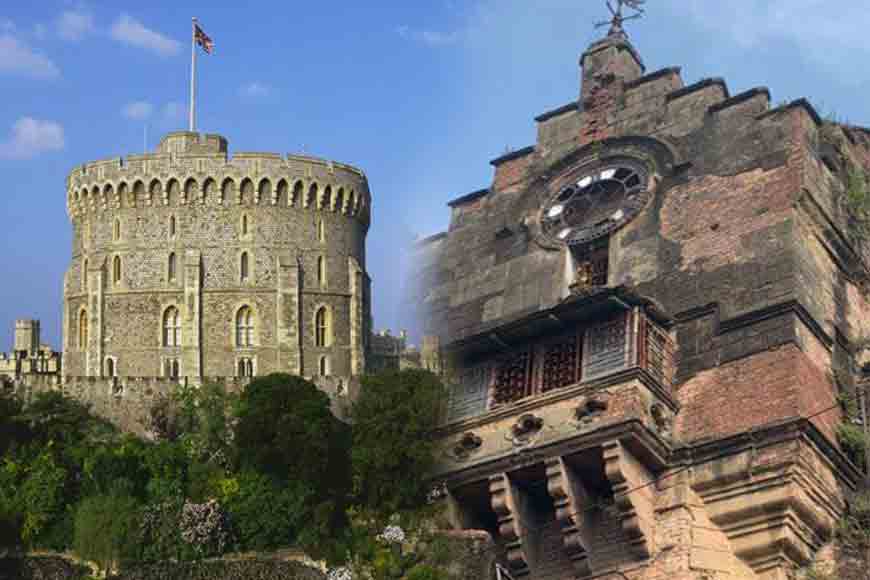Tagore Castle of Kolkata was built according to Windsor Castle

If you walk down 26 Prasanna Kumar Thakur Street, you get to see an old dilapidated castle on your right, along Jorabagan near Pathuriaghata. Unlike the Jorasanko Thakurbari, this ‘The Tagore Castle’ is not related to Rabindranath Tagore or to his illustrious family that created many stalwarts of that era. This building is in shambles though, and this fading grandeur reminds one of the imposing structures that Kolkata has always boasted of. One step near the imperial house, forces a flock of pigeons to fly out in fear. They ave made homes in the innumerable crevices of this building.
But who made this castle? It was Jatindramohan Tagore who built it in 1895. It is believed Kali Kumar handed over the ownership of this mansion to his brother Prasannakumar. Prasannakumar was an extremely meritorious student of Hindu College, the editor of the magazine ‘Reformer’ and later founded the ‘Hindu Theatre.’ He was such an important figure in the then society, that many streets in the area are today named after him. The houses on 13, 13A and 13B are known as Tagore Palace and on the opposite of it is this renowned Tagore Castle, built on the likes of Windsor Castle of England.
In those days, Bengal’s zamindars and aristocrats tried to show off their wealth and power, by following British art, culture, literature and architecture. This tendency even led the family of the Tagore Castle to hoist the Union Jack on its rooftop. This indeed reflected the impact of colonialism on the lives of Bengalis of the 19th-century. Tagore Castle was built with the help of Mackintosh Burn. There was a tower inside the palace which was 100 feet tall and with that a clock tower constructed like the Big Ben. The ‘dance room’ on the third floor is famous and once upon a time, many dramas were staged in this room.
The first owner of Tagore Castle, Jatindramohan is as illustrious as the building. He was the secretary and later president of British-Indian Association, who even earned the Maharaja-Bahadur title. His name was also associated with Asiatic Society, University of Calcutta, Mayo Hospital, Museum and so on. He was also deeply interested in music and patronised the first ‘surbahar’ programme and started Rangyanatyalaya in Pathurighata. Being a friend of Madhusudan Dutta, Jatindramohan encouraged him to write Tilottoma Sombhab Kabya and gave him money to publish the book. He was also closely associated with the shinning stars of Bengali culture like Ishwar Gupta, Bankim Chandra Chattopadhyay and others.
When Job Charnock founded the city of Kolkata, this area was thinly populated. Certain people resided in Burrabazar for business purpose and Jorabagan featured as the farm-house of the Sheths. North Calcutta became full of life only after the battle of Plassey. Gradually, Sobhabazar and Pathuriaghata became popular. The Tagores had come to Kolkata and stayed in various parts of the city. Eventually, they settled in Pathuriaghata. Sripanchanan Tagore had laid the foundation stone of the Tagore family in Kolkata. He was wise enough to opt for ‘Captain Pakrao’ - the work of supplying goods to the captains and other workers of the ship and had earned enough money.
But Sripanchanan’s son Jayaram did not follow his footsteps. He used to work in Kolkata’s zamindari office. He had two wives and three sons - Darpanarayan, Nilmoni and Govindaram. Darpanarayan was known for his magisterial nature. The British used to address him as ‘Merchant of Calcutta.’ Darpanarayan did business in Kolkata while Nilmoni stayed in Orissa. They erected the huge castle of Pathuriaghata. But after the demise of Gobindaram’s demise, there started a dispute regarding the property. Consequently, Prince Dwarakanath and Maharshi Debendranath Tagore were the first to give recognition to Jorasanko Thakurbari. Thereafter, Jorabagan and Jorasanko became the hub of art, culture, music and education primarily because of the Tagore family.
But you will find no traces of this fascinating history in any corner of this castle today. Busy lanes, countless people, tenants, families who have occupied the house illegally, hinged electric wires, ramshackle gates, shrubs…. They all bear testimony to the ruins. Hope this sign of heritage will not fall prey to city developers!










